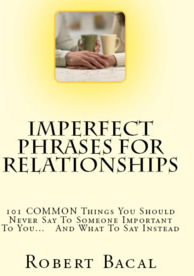All Couples Should Learn To FIght Fair. Here's How
Check out our mini-guide on how to fight fair, and stop letting badly handled conflict cause pain in your relationships. Download it NOW!
Search Our Network Of Business and Personal Development Sites
The Power of Acknowledgement In Conflict Resolution
Using The CARP System To Manage Conflict Constructively - Part II (Acknowledge)
Editor's Note. This is part of a three part series. To view parts one and three, click the links at the bottom of the article.
Last week we introduced you to the CARP system; a simple model to help you sequence and manage conflict more effectively. In the previous article we covered the "C" in the model -- CONTROL. We indicated that in order to manage conflict more effectively we need to exhibit self-control and attempt to control/influence the behavior of the other party. The latter is based on the principle that it's important to remove the rewards we may be giving the other person for their aggressive and/or emotional behavior.
Now we turn to the "A" of the model - Acknowledge
A is For Acknowledge
To deal with conflict and prevent escalation it's critical that you ACKNOWLEDGE the other person in two important ways. First, you need to PROVE to the other person that you understand his/her emotional state. Second, you need to PROVE to the other person that you understand his position on the issue. Why? One of the prime contributors to escalation and a move to destructive conflict situations occurs when one (or both) parties feels that the other person is not listening, lacks understanding, or is not interested in what s/he has to say.
So, while you are maintaining some semblance of control, you also need to acknowledge the person.
Here's an important point. Notice that we used the word "PROVE". We mean it. You need to acknowledge in ways that leave no doubt in the mind of the other person that you DO understand. So, it's necessary to be specific.
Acknowledgement Tools
Acknowledgement tools are simple, and easy to use, once you get the hang of them. You probably know about them already. To acknowledge the emotional state/feelings of the other person, you can use "empathy statements". These statements (they can be questions) simply restate your observation about the person's emotions in a neutral, non-threatening way. For example:
"I can see that you are very concerned about how we
are managing our finances"
"It seems to me that you are upset about something
I've said. Is that right?"
"It looks to me like you are very angry about [fill
in the blank]"
Keep your empathy statements short and to the point. Empathy statements should not be used to begin a long lecture. You may need to use a number of them in a row, and if you do so effectively you might notice the other person calming down a bit.
You also need to acknowledge the person's position. The best tool for that purpose is some form of active or reflective listening. What you do is wait for an opportunity to speak, then rephrase what the person has told you (in summary form and in a non-blaming way). Again, your rephrasing should be short and to the point, and it's always good to do a "check question" at the end. For example:
"I want to make sure I understand. You are saying
that you think I should work on this project since I have
more free time than you. Is that accurate?"
"Are you saying that it would help you if I would do
the dishes once in a while?"
Remember, for both listening and empathy, you need to be specific -- to prove your understanding. Otherwise it just doesn't work.
So, where are we? Control and Acknowledgement are designed to remove some of the destructive emotional force from conflict situations. Our purpose in these two stages is not to solve the problem or issue (YET), but to lay the ground-work so we can work together to solve it. When you use control and acknowledgement effectively, you should see some calming of the situation.
Next time: more on the CARP system and conflict; we'll look at making the transition from dealing with the emotions to dealing with the actual conflict issue..
[View Part I] [View Part II] [View Part III]
For more on conflict check out the book called Conflict Prevention In The Workplace - Using Cooperative Communication
© Copyright Robert Bacal, 2000 . Reproduction in any form, electronic or print is forbidden without obtaining permission.
 Manage Conflict - Resolve Conflict - Prevent Conflict
Manage Conflict - Resolve Conflict - Prevent Conflict 

